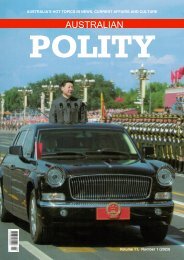Australian Polity, Volume 9 Number 3 - Digital Version
Australia's hot topics in news, current affairs and culture
Australia's hot topics in news, current affairs and culture
Create successful ePaper yourself
Turn your PDF publications into a flip-book with our unique Google optimized e-Paper software.
relationship. One which has immense value in the broader
national security and policy realm. The Pacific Step-up is
Australia’s enduring commitment to supporting our near
neighbours in a range of areas – like capacity building,
humanitarian assistance, and disaster response.
We also want to work with Indonesia, with Singapore,
and other partners in Southeast Asia – building on our
already strong relationships and in so doing, supporting
ASEAN’s centrality in our regional security architecture.
I am focused on ensuring Australia’s military activities
contribute to stability and to peace: to protecting the
maritime trade corridors upon which we all rely and
prosper; to maintaining freedom of navigation and
overflight in accordance with the United Nations
Convention on the Law of the Sea and to deterring the
most egregious forms of coercion and aggression. That
is why we are working with the United States and our
like-minded friends. It is why I am eager to level-up our
defence engagement and our joint training initiatives.
The Australian Defence Force regularly undertakes bilateral
and multilateral defence training activities and
deployments. Like joint and trilateral passage exercise
in the region. Like Exercise Talisman Sabre. Like the
biennial Exercise Rim of the Pacific – hosted by the US
and which last year involved 10 nations, including seven
from the Indo-Pacific. Or like Exercise Malabar – hosted
by India but also involving Japan and United States. The
appetite for – indeed the necessity of – these defence
activities is increasing.
A core component of our collaboration is the US Force
Posture Initiatives. Since 2012, we have hosted US
marines in Darwin as part of a rotational force. The
number of marines has grown from 200 to over 2,000 –
I want to see that number increase further.
Another initiative is enhanced air cooperation between
our air forces, now in its fourth year. Given Australia’s
geographic location – our strategic position in the
Indo-Pacific – and our defence infrastructure in the
Northern Territory and Queensland, I think there is a
clear opportunity to strengthen the US Force Posture
Initiatives.
Future Collaboration
At the same time, there are clear opportunities to deepen
our two nations’ industrial base collaboration. We can
work even closer together on defence capabilities,
on infrastructure, on science and on technology. The
emergence of new and disruptive technologies is
altering the nature of warfare. The boundaries between
conflict and competition are becoming increasingly
blurred. The cyber realm, economics, trade, resources,
and digital media are but some areas being used as
coercive battering rams – or indeed, being weaponised
in new ways. Consequently, the arenas of tension have
expanded, making the prospect of military conflict sadly
less remote than in the past – especially as a result of
miscalculation or indeed misunderstanding.
We need to pool our know-how and resources in ways
that sustain our capability edge. That means maintaining
investment in our core military capabilities – like
submarines, frigates and fighter jets. While continuing
to develop capabilities to hold a potential adversary’s
forces and infrastructure at risk from a greater distance.
Capabilities which send a clear deterrent message to any
adversary: that the cost they would incur in threatening
our interests outweighs the benefits of so doing. These
include new long-range strike weapons, offensive and
defensive cyber, and area denial systems. And capabilities
which can be produced in bulk, more quickly and cheaply,
and where their loss would be more tolerable, without
significantly impacting our force posture.
I am referring to assets like autonomous craft and
remotely piloted drones. Assets which can undertake
multifaceted missions, be used in a swarm capacity, or
teamed with traditional manned capabilities for force
multiplier effects. The unmanned Loyal Wingman is I think
the most impressive military combat aircraft that we have
seen recently and to be designed in Australia for more
than half a century. It’s a partnership between the Royal
Australian Air Force and Boeing Australia. This aircraft
– and the underlying ecosystem of Australian industry –
is an insight into the potential of future capabilities and
what can be achieved in partnership.
Our Government’s investment in Australia’s defence
Australian Polity 39





